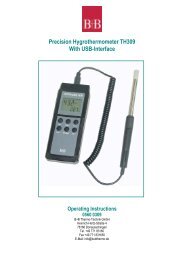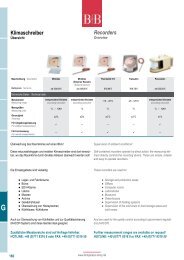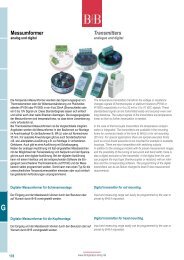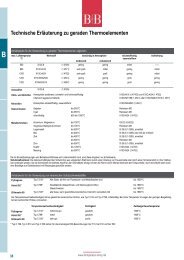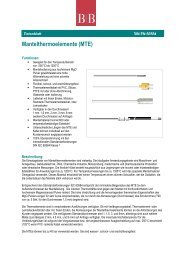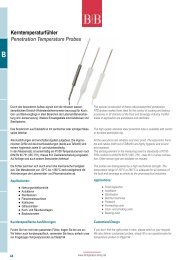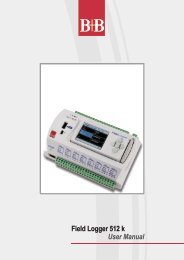B - Temperatur-Shop
B - Temperatur-Shop
B - Temperatur-Shop
You also want an ePaper? Increase the reach of your titles
YUMPU automatically turns print PDFs into web optimized ePapers that Google loves.
Detector<br />
Transducer which produces a voltage or current proportional to the electromagnetic<br />
energy incident upon it. See also Thermopile, MCT, Thermoelectric Cooled, Pyroelectric,<br />
and Lead Selenide and Si detectors.<br />
Dew point<br />
The dew point is the temperature up to which the gas is to be cooled down<br />
so that straight water vapour condenses out as liquid. Normally dew point is<br />
valid only for temperatures above the freezing point. In certain cases, water<br />
can also condense below the freezing point of liquid. However, in such a<br />
case, the dew point temperature is not identical with the frost point temperature.<br />
Dielectric Withstand (Breakdown Voltage)<br />
The maximum voltage an insulator of electricity can endure without voltage electrical<br />
conduction through the material.<br />
Digital Data Bus<br />
Two or more electrical conductors connecting several transmitters and receivers of digital<br />
data.<br />
Digital Image Processing<br />
Converting an image to digital form and changing the image to enhance it or prepare it for<br />
analysis by computer or human vision. In the case of an infrared image or thermogram,<br />
this could include temperature scaling, spot temperature measurements, thermal profiles,<br />
image addition, subtraction, averaging, filtering, and storage.<br />
Digital Output Interval<br />
The time interval between transmission of packets of digital data (DOI) containing temperature<br />
and system status information.<br />
DIN Deutsches Institut<br />
The German standard for many instrumentation products.<br />
Drift<br />
The change in instrument indication over a period of time not caused by external influences<br />
on the device.<br />
E<br />
EMI/RFI<br />
Electro-Magnetic Interference/Radio Frequency Interference, which affects the performance<br />
of electronic equipment.<br />
Emissivity<br />
At a given wavelength the ratio of infrared energy radiated by an object at a given<br />
temperature to that emitted by a blackbody at the same temperature The emissivity of a<br />
blackbody is unity at all wavelengths.<br />
Enthalpy<br />
The enthalpy is a measure of the energy which is necessary to bring the gas at a certain<br />
temperature, pressure and humidity condition into another condition. The zero point of the<br />
enthalpy has been fixed at 0 °C and 0 %RH. In practice, it is often not the absolute value<br />
but the difference of Enthalpy between two climate-conditions of interest.<br />
Environmental Rating<br />
A rating given (usually by agencies and regulatory bodies) to indicate the severity of the<br />
environment in which the unit will function reliably.<br />
214<br />
www.temperatur-shop.de<br />
External Reset (Trigger)<br />
Initialization of an instrument to its state at power up including signal<br />
conditioning features (Peak Hold, Valley Hold, Sample Hold, Average, (1-way RS232,<br />
etc.) via the external reset input.<br />
F<br />
Fahrenheit or F<br />
<strong>Temperatur</strong>e measurement scale where, at standard atmospheric pressure, the freezing<br />
point of water is 32 °F and the vaporization point of water is 212 °F. To convert from<br />
Celsius, use F = (C x 1.8) + 32.<br />
Fail-safe Operation<br />
A measurement distance sufficiently large (typically greater than 10 times the focal<br />
distance) whereby the spot size of an instrument is growing in direct proportion to the<br />
distance from the instrument, and the field of view is constant.<br />
Far Field<br />
A measurement distance sufficiently large (typically greater than 10 times the focal<br />
distance) whereby the spot size of an instrument is growing in direct proportion to the<br />
distance from the instrument, and the field of view is constant.<br />
Field of View (FOV)<br />
The area or solid angle viewed through an optical or infrared instrument. Typically<br />
expressed by giving the spot diameter of an instrument and the distance to that spot.<br />
Also expressed as the angular size of the spot at the focal point. See Optical or Infrared<br />
Resolution.<br />
Focal Point or Distance<br />
The point or distance from the instrument at which the object is focused onto the detector<br />
within the instrument. The focal point is the place or distance at which the optical or<br />
infrared resolution is greatest.<br />
Frost point<br />
The frost point is the temperature up to which the gas is to be cooled down<br />
so that straight water vapour gets condensed to ice. The frost point is valid<br />
only for temperatures below the freezing point.<br />
Full Scale Accuracy<br />
The temperature measurement accuracy expressed as a percentage of the maximum<br />
possible reading of an instrument.<br />
G<br />
Gray Body<br />
A source of radiant emissions for which the emissivity is less than 1 but constant and,<br />
therefore, independent of wavelength.<br />
I<br />
IEC International Electrotechnical Commission<br />
A European organization that coordinates and sets related standards among the European<br />
Community.<br />
IEEE-488<br />
A standard developed by Hewlett-Packard Corporation and adopted by the IEEE for<br />
digital interface between programmable instrumentation. It uses a 16-bit bus to interconnect<br />
up to 15 instruments. The standard comprises hardware and protocol options. It is<br />
also called the Hewlett-Packard Interface Bus (HPIB) or General Purpose Interface Bus<br />
(HPIB) or General Purpose Interface Bus (GPIB). The present standard is ANSI/IEEE-<br />
4881-1987.






